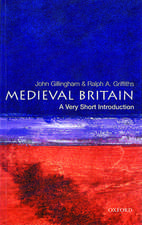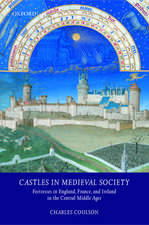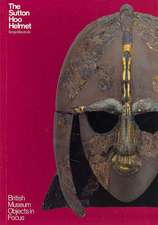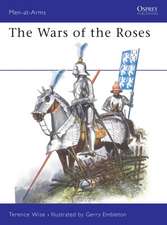Written World – Past and Place in the Work of Orderic Vitalis
Autor Amanda Jane Hingsten Limba Engleză Paperback – 14 apr 2009
The Anglo-Norman monk Orderic Vitalis (1075-c.1142) wrote his monumental, highly individual Historia Ecclesiastica as an exercise in monastic discipline intended to preserve the events and character of Christendom for future generations. Though cloistered since childhood in a Benedictine monastery near Normandy's southern border, Orderic gained access to an intellectual world that extended from Scotland to Jerusalem through his engagement with texts and travelers that made their way into his monastic milieu. His Historia Ecclesiastica, with a breadth of vision unparalleled in its time, is a particularly fertile source for an investigation of concepts of space and historiography in the high Middle Ages.
In The Written World: Past and Place in the Work of Orderic Vitalis, Amanda Jane Hingst draws on the blend of intellectual intimacy and historiographical breadth in Orderic's writings to investigate the ways in which high medieval historians understood geographical space to be a temporally meaningful framework for human affairs. Hingst explores Orderic's manipulation of the classical geographical tradition, his balancing of spatial scale between the local and the universal, and his sophisticated and original utilization of the new intellectual currents of the twelfth century. She argues that Orderic, along with some of his contemporaries, interpreted Christendom's terrain not merely as a static stage for human action but as a meaningful element in human history. Using a theoretical framework marrying modern spatial theory with medieval philosophical traditions, Hingst suggests that, at its most nuanced, medieval historiography affirmed the symbolic topography of Christendom by linking history and geography in such a way that they mutually forged and reinforced each other. With a clarity of style and ideas, Hingst makes available to both students and trained scholars a fascinating account of a heretofore underappreciated medieval figure and his work.
“Amanda Hingst has written a wonderful book—learned, brilliant in concept, and graceful in execution. She provides the most thorough reading of the full text of the most interesting historian of the twelfth century, Orderic Vitalis, and, in so doing, contributes significantly to the study of historiography and the reading of the history of the period.” —Robert M. Stein, Doris and Carl Kempner Distinguished Professor of Humanities, Purchase College“Orderic Vitalis is one of the great twelfth-century historians who is both cursorily well-known and hardly known at all in any deep sense. Amanda Hingst offers us a substantial remedy for that lack by taking seriously an aspect of reality that Orderic (but not his modern readers) took seriously: the readable natural world of landscape, traversable space, and dramatic weather, all fraught with meaning for history. Hingst writes from a well-chosen critical place uniting the historian's specificity with the literary critic's sensitivity to map the topography of meanings that Orderic inscribed into the physical settings for the historical events he narrated. Hingst's clever choice of interpretive focus respects both medieval and modern senses of historical reality, and contributes
significantly to our still growing awareness of the depth and complexity of medieval historical writing.” —Nancy Partner, McGill University
“The Written Worldlives up to its audacious title. Wry, cool, and unflappably alert, it makes brilliant sense of Orderic Vitalis's baffling and luxuriant composition. We have here the work of a historian who can teach literary scholars something about how to read.” —Steven Justice, University of California, Berkeley
“The Written Worldis a wonderful, innovative, and beautifully written study of Orderic Vitalis’s Historia Ecclesiastica. Amanda Hingst vividly evokes the meaning and function of history for an Anglo-Norman monk at the end of the eleventh century and the beginning of the twelfth. She emphasizes how geographical space provided a temporal framework through which Orderic Vitalis narrated and experienced historical events. The landscape of Christendom, far from being an unchanging backdrop to human deeds, actively participated in the history of the world. Heaven was glimpsed on earth as God manipulated fields and streams, trees and clouds, tempests and dirt with a divine purpose. This book is a major contribution to the intellectual history of the High Middle Ages.” —Mark Gregory Pegg, Washington University
Preț: 319.65 lei
Nou
Puncte Express: 479
Preț estimativ în valută:
61.16€ • 63.87$ • 50.51£
61.16€ • 63.87$ • 50.51£
Carte tipărită la comandă
Livrare economică 15-29 aprilie
Preluare comenzi: 021 569.72.76
Specificații
ISBN-13: 9780268030865
ISBN-10: 0268030863
Pagini: 312
Dimensiuni: 152 x 229 x 18 mm
Greutate: 0.45 kg
Ediția:1st Edition
Editura: MR – University of Notre Dame Press
ISBN-10: 0268030863
Pagini: 312
Dimensiuni: 152 x 229 x 18 mm
Greutate: 0.45 kg
Ediția:1st Edition
Editura: MR – University of Notre Dame Press
Recenzii
“Amanda Jane Hingst’s book is an eminently readable, continually engaging account of Orderic’s understanding of the world around him, designed on the principle that geographical and topographical space was his primary mode of historical thought. . . . This is a consistently intelligent, thought-provoking, beautifully written book, and a valuable contribution to the field.” —Journal of English and Germanic Philosophy
“Orderic Vitalis was not a particularly influential historian during the Middle Ages, but for modern scholars his vast, detailed, and often idiosyncratic history is a crucial source for studying Western Europe, particularly Normandy and England, in the eleventh and early twelfth centuries. As Amanda Jane Hingst’s clever title indicates, her book focuses on place, space, and geography in Orderic’s work. . . her fascinating work enriches our understanding of an important medieval author and will also open up new avenues into thinking about place and geography in medieval writings.” —Church History
“Using the twelfth-century chronicle of the Anglo-Norman monk, Orderic Vitalis, as her base, Amanda Hingst has constructed an elegantly written, engaging text that explores medieval understandings of place and time. This ambitious work takes the unusual approach of grounding the historian’s understanding of his wider world by locating him within his physical environment.” —Parergon
“Hingst’s far-ranging study, with its lush descriptions of landscape and provocative arguments, offers a compelling call to read Orderic’s history as the complete and spiritually anchored creation of a thoughtful man of his age.” —American Historical Review
Notă biografică
Amanda Jane Hingst is an independent scholar in Madison, Wisconsin.

















